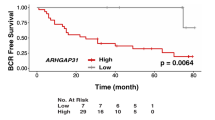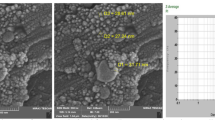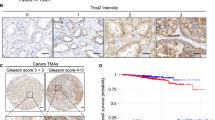Abstract
Stromal expression of some matrix metalloproteinases (MMPs) has been associated with increasing tumour burden in prostate cancer. We investigated the expression of mRNA (by RT-PCR) and protein (by zymography and western blotting) of MMPs and endogenous inhibitors (tissue inhibitors of metalloproteinases, TIMPs) in two parent epithelial prostate cancer cell lines and sublines of increasing invasive/metastatic potential. Expression of membrane type MMPs, MT1-MMP and MT3-MMP mRNA was higher in PC3-derived than in LNCaP-derived lines, whereas MT2-MMP mRNA expression was higher in the LNCaPderived than in PC3-derived cell lines. Active MT1, MT2 and MT3-MMP protein levels were similar in all lines, but processed MT-MMPs, indicative of latent MMP activation, were increased in more aggressive sublines. Expression of MMP-1, MMP-13 and TIMP-1 was higher in the more aggressive sublines and may be implicated in invasive/metastatic ability. Regulation of MMP-1 and MMP-13 expression may offer important therapeutic options for treating patients with prostate cancer.
This is a preview of subscription content, access via your institution
Access options
Subscribe to this journal
Receive 4 print issues and online access
$259.00 per year
only $64.75 per issue
Buy this article
- Purchase on Springer Link
- Instant access to full article PDF
Prices may be subject to local taxes which are calculated during checkout





Similar content being viewed by others
References
Kantoff PW, Wishnow KI, Loughlin KR . Prostate Cancer: a Multidisciplinary Guide. Blackwell Science: Massachusetts. 1997. 296 pp
Yoneda T . Cellular and molecular mechanisms of breast and prostate cancer metastasis to bone. Eur J Cancer 1998; 34: 240–245.
Lichte A, Kolkenbrock H, Tschesche H . The recombinant catalytic domain of membrane-type matrix metalloproteinase-1 (MT1-MMP) induces activation of progelatinase A and progelatinase A complex with TIMP-2. FEBS Lett 1996; 397: 277–282.
Matrisian LM . Melloproteinases and their inhibitors in matrix remodelling. Trends Gen 1990; 6: 121–125.
Ray JM, Stetler-Stevenson WG . The role of matrix metalloproteases and their inhibitors in tumour invasion, metastasis and angiogenesis. Eur Resp J 1994; 7: 2062–2072.
Birkedal-Hansen H . Proteolytic remodelling of extracellular matrix. Curr Opin Cell Biol 1995; 7: 728–735.
Curran S, Murray GI . Matrix metalloproteinases in tumour invasion and metastasis. J Pathol 1999; 189: 300–308.
Nagase H, Woessner JF . Matrix metalloproteinases. J Biol Chem 1999; 274: 21491–21494.
Seiki M . Membrane-type matrix metalloproteinases. APMIS 1999; 107: 137–143.
Ellerbroek SM, Stack MS . Membrane associated matrix metalloproteinases in metastasis. BioEssays 1999; 21: 940–949.
Sato H, et al. Matrix metalloproteinase expressed on the surface of invasive tumour cells. Nature 1994; 370: 61–65.
Takino T, Sata H, Shinagawa A, Seiki M . Identification of the second membrane-type matrix metalloproteinase (MT-MMP-2) gene from a human placenta cDNA library. J Biol Chem 1995; 270: 23013–23020.
Puente XS, et al. Molecular cloning of a novel membrane-type matrix metalloproteinase from a human breast carcinoma. Cancer Res 1996; 56: 944–949.
Will H, Hinzmann B . cDNA sequence and mRNA tissue distribution of a novel human matrix metalloproteinase with a potential transmembrane domain. Eur J Biochem 1995; 231: 602–608.
Pei D . Identification and characterisation of the fifth membrane-type matrix metallo-proteinase MT5-MMP. J Biol Chem 1999; 274: 8925–8932.
Atkinson S, et al. Intermolecular autolytic cleavage can contribute to the activation of progelatinase A by cell membranes. J Biol Chem 1995; 270: 30479–30485.
Strongin AY, et al. Mechanism of cell surface activation of 73kDa type IV collagenase. J Biol Chem 1995; 270: 5331–5338.
Knauper V, et al. Cellular mechanisms for human procollagenase-3 (MMP-13) activation. Evidence that MT1-MMP (MMP-14) and gelatinase A (MMP-2) are able to generate active enzyme. J Biol Chem 1996; 271: 17124–17131.
Stanton H, et al. The activation of proMMP-2 (gelatinase A) by HT1080 fibrosarcoma cells is promoted by culture on a fibronectin substrate and is concomitant with an increase in processing of MT1-MMP (MMP-14) to a 45kDa form. J Cell Sci 1998; 111: 2789–2798.
Lohi J, et al. Regulation of membrane-type matrix metalloproteinase-1 expression by growth factors and phorbol 12-myristate 13-acetate. Eur J Biochem 1996; 239: 239–247.
Ohuchi E, et al. Membrane type 1 matrix metalloproteinase digests interstitial collagens and other extracellular matrix macro-molecules. J Biol Chem 1997; 272: 2446–2451.
Henriet P, Blavier L, Declerck YA . Tissue inhibitors of metalloproteinases (TIMP) in invasion and proliferation. APMIS 1999; 107: 111–119.
Brown PD, Giavazzi R . Matrix metalloproteinase inhibition: a review of anti-tumour activity. Ann Oncol 1995; 6: 967–974.
Jung L, et al. Matrix metallo-proteinases 1 and 3, tissue inhibitor of metalloproteinase-1 and the complex of metallo-proteinase-1/tissue inhibitor in plasma of patients with prostate cancer. Int J Cancer 1997; 74: 220–223.
Baker T, et al. Serum metallo-proteinases and their inhibitors: markers for malignant potential. Br J Cancer 1994; 70: 506–512.
Still K, et al. Localization and quantification of mRNA for matrix metalloproteinase-2 (MMP-2) and tissue inhibitor of matrix metalloproteinase-2 (TIMP-2) in human benign and malignant prostatic tissue. Prostate 2000; 42: 18–25.
Wood M, et al. In situ hybridization studies of metalloproteinases 2 and 9 and TIMP-1 and TIMP-2 expression in human prostate cancer. Clin Exp Metastasis 1997; 15: 246–258.
Gohji K, et al. Serum matrix metalloproteinase-2 and its density in men with prostate cancer as a new predictor of disease extension. Int J Cancer 1998; 79: 96–101.
Boag H . Transforming growth factor-beta-1 and matrix metalloproteinases in prostatic adenocarcinoma and hyperplasia-coordinated patterns of immunohistochemical expression. Appl Immunohistochem 1997; 5: 246–251.
Montironi R, et al. Immunohistochemical evaluation of type IV collagenase (72-kD metalloproteinase) in prostatic intraepithelial neoplasia. Anticancer Res 1996; 16: 2057–2062.
Stearns M, Stearns ME . Evidence for increased activated metalloproteinase 2 (MMP-2a) expression associated with human prostate cancer progression. Oncol Res 1996; 8: 69–75.
Stearns M, Stearns ME . Immunohistochemical studies of activated matrix metalloproteinase-2 (MMP-2a) expression in human prostate cancer. Oncol Res 1996; 8: 63–67.
Hashimoto K, Kihara Y, Matuo Y, Usui T . Expression of matrix metallo-proteinase-7 and tissue inhibitor of metalloproteinase-1 in human prostate. J Urol 1998; 160: 1872–1876.
Hamdy FC, et al. Matrix metalloproteinase 9 expression in primary human prostatic adenocarcinoma and benign prostatic hyperplasia. Br J Cancer 1994; 69: 177–182.
Upadhyay J, et al. Membrane type 1-matrix metalloproteinase (MT1-MMP) and MMP2 immunolocalization in human prostate: change in cellular localization associated with high-grade prostatic intraepithelial neoplasia. Clin Cancer Res 1999; 5: 4105–4110.
Pyke C, Ralfkilaelr E, Tryggvason K, Dano K . Messenger RNA for two type IV collagenases is located in stromal cells in human colon cancer. Am J Pathol 1993; 142: 359–365.
Bassett P, et al. A novel metalloproteinase gene specifically expressed in stromal cells of breast carcinomas. Nature 1990; 348: 699–704.
Okada A, et al. Membrane-type matrix metalloproteinase (MT-MMP) gene is expressed in stromal cells of human colon, breast and head and neck carcinomas. Proc Natl Acad Sci USA 1995; 92: 2730–2734.
Horoszewicz JS, et al. LNCaP model of human prostatic carcinoma. Cancer Res 1983; 43: 1809–1818.
Navone NM, Logothetis CJ, von Eschenbach AC, Troncoso P . Model systems of prostate cancer: Uses and limitations. Cancer Metast Rev 1999; 17: 361–371.
Gleave M, et al. Acceleration of human prostate cancer growth in vivo by factors produced by prostate and bone fibroblasts. Cancer Res 1991; 51: 3753–3761.
Wu HC, et al. Derivation of androgen-independent human LNCaP prostatic cancer cell sublines: role of bone stromal cells. Int J Cancer 1994; 57: 406–412.
Wu TT, et al. Establishing human prostate cancer cell xenografts in bone: induction of osteoblastic reaction by prostate-specific antigen-producing tumors in athymic and SCID/bg mice using LNCaP and lineage-derived metastatic sublines. Int J Cancer 1998; 77: 887–894.
Thalmann GN, et al. Androgen-independent cancer progression and bone metastasis in the LNCaP model of human prostate cancer. Cancer Res 1994; 10: 2577–2581.
Kaighn ME, et al. Establishment and characterisation of a human prostatic carcinoma cell lien (PC3). Invest Urol 1979; 17: 16–23.
Pettaway CA, et al. Selection of highly metastatic variants of different human prostate carcinomas using orthotopic implantation in nude mice. Clin Cancer Res 1996; 2: 1627–1636.
Stephenson RA, et al. Metastatic model for human prostate cancer using orthoptopic implantation in nude mice. J Natl Cancer Inst 1992; 84: 951–957.
Repesh LA . A new in vitro assay for quantitating tumour cell invasion. Invasion and Metastasis 1989; 9: 192–208.
Giambernadi TA, et al. Overview of matrix metalloproteinase expression in cultured human cells. Matrix Biol 1998; 16: 483–496.
Ishiguro N, et al. mRNA expression of matrix metalloproteinases and tissue inhibitors of metallo-proteinase in interface tissue around implants in loosening total hip arthroplasty. J Biomed Mater Res 1996; 32: 611–617.
Lyons JG, et al. Characteristics of a 95-kDa matrix metalloproteinase produced by mammary carcinoma cells. Biochemistry 1991; 30: 1449–1456.
Hurwitz A, Dushnik M, Solomon H, Yagel S . Cytokine-mediated regulation of rat ovarian function: interleukin-1 stimulates the accumulatioin of a 92-kilodalton gelatinase. Endrocrinology 1993; 132: 2709–2714.
Perkinson RA, Kuo BA, Norton PA . Modulation of transcription of the rat fibronectin gene by cell density. J Cell Biochem 1996; 63: 74–85.
Ballock RT, et al. TGF-β1 prevents hypertrophy of epiphyseal chondrocytes: regulation of gene expression for cartilage matrix proteins and metalloproteinases. Devel Biol 1998; 158: 414–429.
Wagner S, et al. Expression of matrix metalloproteinases in human glioma cell lines in the presence of Il-10. J. Neurol Oncol 1998; 40: 113–122.
Sanchez-Sweatman OH, Orr FW, Singh G . Human metastatic prostate PC3 cell lines degrade bone using matrix metalloproteinases. Invasion Metastasis 1999; 18: 297–305.
Goltzman D . Mechanisms of the development of osteoblastic metastases. Cancer 1997; 80: 1581–1587.
Cooper CR, Pienta KJ . Cell adhesion and chemotaxis in prostate cancer metastasis to bone: a minireview. Prostate Cancer Prostat Dis 2000; 3: 6–12.
Stetler-Stevenson WG, Hewitt R, Corcoran M . Matrix metalloproteiinases and tumour invasion: from correlation and causality to the clinic. Sem Cancer Biol 1996; 7: 147–154.
MacDougall JR, Matrisian LM . Contributions of tumour and stromal matrix metallo-proteinases to tumour progression, invastion and metastasis. Cancer Metastas Rev 1995; 14: 351–362.
Segain J-P, et al. Induction of fibroblast gelatinase B expression by direct contact with cell lines derived from primary tumour but not from metastases. Cancer Res 1996; 56: 5506–5512.
Martorana AM, et al. Epithelial cells up-regulate matrix metalloproteinases in cells within the same mammary carcinoma that have undergone an epithelial-mesenchymal transition. Cancer Res 1998; 58: 4970–4979.
Heppner KJ, Matrisian LM, Jensen RA, Rodgers WH . Expression of most matrix metalloproteinase family members in breast cancer represents a tumour-induced host response. Am J Pathol 1996; 149: 273–282.
Benbow U, et al. A novel host/tumour cell interaction activates matrix metallo-proteinase 1 and mediates invasion through type I collagen. J Biol Chem 1999; 274: 25371–25378.
McGuire PG, Seeds NW . The interaction of plasminogen activator with a reconstituted basement membrane matrix and extracellular macromolecules produced by cultured epithelial cells. J Cell Biochem 1989; 40: 215–227.
Dong Z, et al. Differential regulation of matrix metalloproteinase-9, tissue inhibition of metalloproteinase-1 (TIMP-1) and TIMP-2 expression in co-cultures of prostate cancer and stromal cells. Int J Cancer 2001; 93: 507–515.
Ware JL, Paulson DF, Mickey GH, Webb KS . Spontaneous metastasis of cells of the human prostate carcinoma cell line PC-3 in athymic nude mice. J Urol 1982; 128: 1064–1067.
Gonzales-Gronow M, et al. Interaction of plasminogen with dipeptidyl peptidase IV initiates a signal transduction mechanism which regulates expression of matrix metalloproteinase-9 by prostate cancer cells. Biochem J 2001; 355: 397–407.
Pendas AM, et al. An overview of collagenase-3 expression in malignant tumors and analysis of its potential value as a target in antitumor therapies. Clin Chim Acta 2000; 291: 137–155.
Uria JA, et al. Regulation of collagenase-3 expression in human breat carcinomas is mediated by stromal-epithelial cell interactions. Cancer Res 1997; 57: 4882–4888.
Nagakawa O, et al. Expression of membrane-type 1 matrix metalloproteinase (MT1-MMP) on prostate cancer cell lines. Cancer Lett 2000; 155: 173–179.
Desruisseau S, Ghazarossian-Ragni E, Chinot O, Martin P-M . Divergent effect of TGFβ1 on growth and proteolytic modulation of human prostatic-cancer cell lines. Int J Cancer 1996; 66: 796–801.
Achbarou A, et al. Urokinase overproduction results in increased skeletal metastasis by prostate cancer cells in vivo. Cancer Res 1994; 54: 2372–2377.
Sehgal I, Baley PA, Thompson TC . Transformsing growth factor beta 1 stimulates contrasting responses in metastatic versus primary mouse prostate cancer-derived cell lines in vitro. Cancer Res 1996; 56: 3359–3365.
Festuccia C, et al. Osteoblast-derived TGF-β1 modulates matrix degrading protease expression and activity in prostate cancer cells. Int J Cancer 2000; 85: 407–415.
Sehgal I, Thompson TC . Novel regulation of type IV collagenase (matrix metallo-proteinase-9 and -2) activities by transforming growth factor-β1 in human prostate cancer cell lines. Mol Biol Cell 1999; 10: 407–416.
Yonou H, et al. Establishment of a novel species- and tissue-specific metastasis model of human prostate cancer in humanized non-obese diabetic/severe combined immunodeficient mice engrafted with human adult lung and bone. Cancer Res 2001; 61: 2177–2182.
Attisano L, Lee-Hoeflich ST . The smads. Genone Biol 2001; 2 Reviews. 3010.1–3010.8.
Yuan W, Varga J . Transforming growth factor-β repression of matrix metalloproteinase-1 in dermal fibroblasts involves Smad3. J Biol Chem 2001; 276: 38502–38510.
Webber MM, Waghray A, Bello D . Prostate-specific antigen, a serine protease, facilitates human prostate cancer cell invasion. Clin Cancer Res 1995; 1: 1089–1094.
Acknowledgements
Mirella Daja was generously supported by the Sydney Foundation for Medical Research. We would like to thank Professor Kevin Barrow, Faculty of Science, University of New South Wales for helpful discussions.
Author information
Authors and Affiliations
Corresponding author
Rights and permissions
About this article
Cite this article
Daja, M., Niu, X., Zhao, Z. et al. Characterization of expression of matrix metalloproteinases and tissue inhibitors of metalloproteinases in prostate cancer cell lines. Prostate Cancer Prostatic Dis 6, 15–26 (2003). https://doi.org/10.1038/sj.pcan.4500609
Received:
Revised:
Accepted:
Published:
Issue Date:
DOI: https://doi.org/10.1038/sj.pcan.4500609
Keywords
This article is cited by
-
Interleukin-7 Contributes to the Invasiveness of Prostate Cancer Cells by Promoting Epithelial–Mesenchymal Transition
Scientific Reports (2019)
-
Androgen deprivation in LNCaP prostate tumour xenografts induces vascular changes and hypoxic stress, resulting in promotion of epithelial-to-mesenchymal transition
British Journal of Cancer (2016)
-
LIM kinase1 modulates function of membrane type matrix metalloproteinase 1: implication in invasion of prostate cancer cells
Molecular Cancer (2011)
-
Study of matrix metalloproteinases and their inhibitors in prostate cancer
British Journal of Cancer (2010)
-
Tumor-derived matrix metalloproteinase-13 (MMP-13) correlates with poor prognosis of invasive breast cancer
BMC Cancer (2008)



